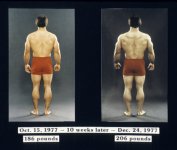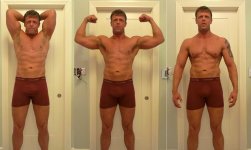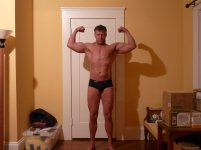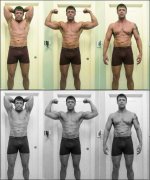alfresco
Featured Member / Kilo Klub Member
Staff member
Super Moderators
Moderator
Featured Member
Kilo Klub Member
Registered
Board Supporter
- Joined
- Jul 29, 2006
- Messages
- 6,408
I recently sent a PM to a well respected member of this board with some
of my unsolicited comments about physique photography. After doing so,
I got to thinking that with many people posting photographs of themselves
with the expectation that they will be used for critical comparison, I thought
it just might be beneficial to address this subject in what I hope to be a
meaningful fashion instead of just offering up criticism.
My intention here is to address the variables associated with the documentation
of your bodybuilding progress through still photography. This is not physique
photography in any artful or creative way. That is another subject altogether.
(By the way, good examples of progress photos are the ones taken of Alex
Azarian during his pre-contest preparation. They are exceptional in my opinion.)
And let me start by saying that I am not a physique photographer. Have never
been one and have zero intention of being one. But I believe I know a little
something about photography that might be worth sharing.
After spending tens of thousands of dollars on drugs, gym memberships,
supplements, huge quantities of food, travel, entry fees, etc, etc . . why
oh why do bodybuilders skimp when it comes to photography and to the
accurate documentation of their progress and eventual condition? I know
I neglected to photograph myself over the period of time when I was actually
producing meaningful results. And I never took any photographs of myself
when I was in what, many considered, my best condition. Though I was never
anywhere near the condition of most, if not all of the members of this board,
in retrospect, I now wish I had such photos. And I'll bet others wish they
had great quality photos of themselves as well.
So for Gods sake, hire or get a good photographer (not me) to capture you at
your best and while you are on the way to being your best. You deserve this after
all the hard work you but into your physique. Besides, if you don't, over the
passage of time, nobody will ever believe you when you tell them how good you
used to look. And you yourself will have forgotten and will fall prey to "the older I
get the better I was" syndrome, while having nothing to back your claims.
And please don't think it is all about the camera. Example . . . a few years ago I
sold a film camera that was a gift to me. This camera had been used to photograph
some of the best bodybuilders of all time and took, what is considered by many
to be, one of the greatest physique photographs of all time. But owning that camera
did not automatically make me a great photographer or even a better photographer.
So, it's not about camera, it is only a tool.
Photographing yourself in the bathroom, then at the beach, then by your swimming pool,
then in your backyard next to your thousand dollar barbeque, then in front of your garage
door and finally in the gym locker room after working out and expecting an accurate
evaluation of your progress, well . . . it just isn't going to happen in my book.
Physique photography, especially when you are in the documentation phase, is really
all about consistency, controlling the variables, and light. Pretty simple stuff, just
like bodybuilding. Use the same camera, the same film speed, the same lens aperture,
under the same light, the same distance from the camera at the same place at the same
time of day and it will go a long way in removing any doubt as to your progress or lack
thereof.
Here are ten basic points . . .
1. Camera. Almost anybody can afford a 35mm digital camera now-a-days or has
access to one of acceptable quality. (A cell phone camera is won't work for what we
are trying to accomplish here.) I don't want to start a mega pixel war here or digress
into a discussion of the merits of digital versus film, but anything from about 7 mega
pixels to the high end 21+ mega pixel 35mm format camera will do just fine. Obviously,
the more mega pixels (data) you can acquire the better, but something within the range
above should do just fine if you are only displaying the image on a monitor. High quality
prints will require more mega pixels than what is needed here.
And for quality reasons, use the lowest possible film speed the lighting conditions can
tolerate. Within reason and by trial and error, more, better light equals a lower film speed
which equals a better quality photograph.
2. Lens. A normal 50mm will work just fine. I prefer a longer lens, 80 - 200mm as this
tends to flatten the background and tends to display you physique in a more, undistorted
fashion. A shorter lens, i.e., < 35mm, used at a distance to depict your physique will, in
my opinion, distort your proportions too much.
3. Aperture. The lens aperture (opening) is also important. On a manual SLR camera
and on some of the higher end point and shoot cameras, you can adjust the lens aperture.
By doing so you can control the depth of field (what is in focus) which will separate you,
the subject, from the foreground and background. I would think something a stop or two
around f5.6. Anything lower, like f2.8, and run the potential of having in / out of focus
issues, anything larger, like f16, and everything is in focus and you become lost in the
shuffle, but this is ultimately environmentally dependent.
4. Light. Available, indoor, outdoor, it does not matter. It just needs to be consistent and
flattering, and used to display your physique to it's advantage. Try to replicate stage
lighting if you can and have a mirror to check your position and how you look. You can get
a flood light fairly inexpensively at any hardware store. Once you have gone to the trouble to
set-up the light, leave it there, do not move it if at all possible. Artificial light is easier to use
and to control than sunlight. As much as I love natural light, sunlight is very difficult to get
exactly the same over the course of time.
Try to avoid using a on-camera strobe / flash. It will wash out the definition when pointed at
your body. And if you do choose to use one, position the strobe to the side or down from
the top and then draw top view a diagram of the of you, the camera, and the strobe so you
can duplicate the set up.
5. Distance. You will probably need a tripod here. And a tape measure. Having these will
allow you measure and set distances more accurately. The distances I am referring to here
are the distance from the subject to the front of the lens, the distance from the centerline
of the camera lens to the ground, and the distance to and your relative position to your source
of light. Know what these measurements are and use them for every photograph. I think a
camera height set about waist level to your subject will give you the desired results. Distance
from the camera is lens length dependent. Generally speaking, being further away is better
then being too close.
6. Location. Indoor or outdoor? I don't think it matters as long as you can duplicate the lighting.
I would lean towards a flat monochromatic background devoid of any patterns, stripes, or back-
ground information. While scenic, outdoor backgrounds and environments are nice and can
be very beautiful, I think they tend to distract from the subject, and that is not the goal here.
7. Time. I would avoid taking photos after working out. The degree of muscular pump is
subject to change and does not accurately depict your "normal" condition and is too hard
to control. Your muscles are at their largest when you wake up in the morning, after your blood
has time to pool into your exterminates thereby increasing your size and vascularity, but that
time is not always practical. What is important though, is to take your photos at the same time
of day as your muscle size and vascularity continually change throughout the day as a function
of your activity and diet.
8. Composition. Three words; fill the frame. And shoot vertical frames. Do the same poses
the same way if at all possible. Burn a few prints and have those handy when shooting. It
will help guide you in your posing and has the added benefit of making you a better poser.
9. Color or black and white? Black and white images in my opinion are better for judging progress
as it removes another subjective barrier, which is color, which can be a distraction. Plus, I just
like they way they look. But ultimately, this is a personal decision.
10. Image size. Like muscles, bigger is better. It is helpful if you desire quality feedback to transmit
the largest possible image at 72 dpi to the your target audience. (Anything over 72 dpi is wasted
data when displayed on a computer monitor) Your host site, if posting to a internet board, typically
has size constraints. Go big or go home. And please don't send a postage stamp size image and
expect a accurate evaluation of your physique.
This is quick and dirty outline. I hope you find this informative useful and gets you thinking in a
logical direction.
Let me conclude with a word to the wise. If you hire somebody to take your photographs, make
sure that you retain all rights to your photographs. If you are paying somebody, you can and
should stipulate this. If they do not agree, then fire them and get somebody else. Protect yourself.
If anybody has any comments, questions, concerns, or suggestions, please chime in. I'm all
ear's (and eyes). This is not about me. With all your help, and cutting out my BS, perhaps, if the
mod's agree, we can make this a sticky in the article's forum.
of my unsolicited comments about physique photography. After doing so,
I got to thinking that with many people posting photographs of themselves
with the expectation that they will be used for critical comparison, I thought
it just might be beneficial to address this subject in what I hope to be a
meaningful fashion instead of just offering up criticism.
My intention here is to address the variables associated with the documentation
of your bodybuilding progress through still photography. This is not physique
photography in any artful or creative way. That is another subject altogether.
(By the way, good examples of progress photos are the ones taken of Alex
Azarian during his pre-contest preparation. They are exceptional in my opinion.)
And let me start by saying that I am not a physique photographer. Have never
been one and have zero intention of being one. But I believe I know a little
something about photography that might be worth sharing.
After spending tens of thousands of dollars on drugs, gym memberships,
supplements, huge quantities of food, travel, entry fees, etc, etc . . why
oh why do bodybuilders skimp when it comes to photography and to the
accurate documentation of their progress and eventual condition? I know
I neglected to photograph myself over the period of time when I was actually
producing meaningful results. And I never took any photographs of myself
when I was in what, many considered, my best condition. Though I was never
anywhere near the condition of most, if not all of the members of this board,
in retrospect, I now wish I had such photos. And I'll bet others wish they
had great quality photos of themselves as well.
So for Gods sake, hire or get a good photographer (not me) to capture you at
your best and while you are on the way to being your best. You deserve this after
all the hard work you but into your physique. Besides, if you don't, over the
passage of time, nobody will ever believe you when you tell them how good you
used to look. And you yourself will have forgotten and will fall prey to "the older I
get the better I was" syndrome, while having nothing to back your claims.
And please don't think it is all about the camera. Example . . . a few years ago I
sold a film camera that was a gift to me. This camera had been used to photograph
some of the best bodybuilders of all time and took, what is considered by many
to be, one of the greatest physique photographs of all time. But owning that camera
did not automatically make me a great photographer or even a better photographer.
So, it's not about camera, it is only a tool.
Photographing yourself in the bathroom, then at the beach, then by your swimming pool,
then in your backyard next to your thousand dollar barbeque, then in front of your garage
door and finally in the gym locker room after working out and expecting an accurate
evaluation of your progress, well . . . it just isn't going to happen in my book.
Physique photography, especially when you are in the documentation phase, is really
all about consistency, controlling the variables, and light. Pretty simple stuff, just
like bodybuilding. Use the same camera, the same film speed, the same lens aperture,
under the same light, the same distance from the camera at the same place at the same
time of day and it will go a long way in removing any doubt as to your progress or lack
thereof.
Here are ten basic points . . .
1. Camera. Almost anybody can afford a 35mm digital camera now-a-days or has
access to one of acceptable quality. (A cell phone camera is won't work for what we
are trying to accomplish here.) I don't want to start a mega pixel war here or digress
into a discussion of the merits of digital versus film, but anything from about 7 mega
pixels to the high end 21+ mega pixel 35mm format camera will do just fine. Obviously,
the more mega pixels (data) you can acquire the better, but something within the range
above should do just fine if you are only displaying the image on a monitor. High quality
prints will require more mega pixels than what is needed here.
And for quality reasons, use the lowest possible film speed the lighting conditions can
tolerate. Within reason and by trial and error, more, better light equals a lower film speed
which equals a better quality photograph.
2. Lens. A normal 50mm will work just fine. I prefer a longer lens, 80 - 200mm as this
tends to flatten the background and tends to display you physique in a more, undistorted
fashion. A shorter lens, i.e., < 35mm, used at a distance to depict your physique will, in
my opinion, distort your proportions too much.
3. Aperture. The lens aperture (opening) is also important. On a manual SLR camera
and on some of the higher end point and shoot cameras, you can adjust the lens aperture.
By doing so you can control the depth of field (what is in focus) which will separate you,
the subject, from the foreground and background. I would think something a stop or two
around f5.6. Anything lower, like f2.8, and run the potential of having in / out of focus
issues, anything larger, like f16, and everything is in focus and you become lost in the
shuffle, but this is ultimately environmentally dependent.
4. Light. Available, indoor, outdoor, it does not matter. It just needs to be consistent and
flattering, and used to display your physique to it's advantage. Try to replicate stage
lighting if you can and have a mirror to check your position and how you look. You can get
a flood light fairly inexpensively at any hardware store. Once you have gone to the trouble to
set-up the light, leave it there, do not move it if at all possible. Artificial light is easier to use
and to control than sunlight. As much as I love natural light, sunlight is very difficult to get
exactly the same over the course of time.
Try to avoid using a on-camera strobe / flash. It will wash out the definition when pointed at
your body. And if you do choose to use one, position the strobe to the side or down from
the top and then draw top view a diagram of the of you, the camera, and the strobe so you
can duplicate the set up.
5. Distance. You will probably need a tripod here. And a tape measure. Having these will
allow you measure and set distances more accurately. The distances I am referring to here
are the distance from the subject to the front of the lens, the distance from the centerline
of the camera lens to the ground, and the distance to and your relative position to your source
of light. Know what these measurements are and use them for every photograph. I think a
camera height set about waist level to your subject will give you the desired results. Distance
from the camera is lens length dependent. Generally speaking, being further away is better
then being too close.
6. Location. Indoor or outdoor? I don't think it matters as long as you can duplicate the lighting.
I would lean towards a flat monochromatic background devoid of any patterns, stripes, or back-
ground information. While scenic, outdoor backgrounds and environments are nice and can
be very beautiful, I think they tend to distract from the subject, and that is not the goal here.
7. Time. I would avoid taking photos after working out. The degree of muscular pump is
subject to change and does not accurately depict your "normal" condition and is too hard
to control. Your muscles are at their largest when you wake up in the morning, after your blood
has time to pool into your exterminates thereby increasing your size and vascularity, but that
time is not always practical. What is important though, is to take your photos at the same time
of day as your muscle size and vascularity continually change throughout the day as a function
of your activity and diet.
8. Composition. Three words; fill the frame. And shoot vertical frames. Do the same poses
the same way if at all possible. Burn a few prints and have those handy when shooting. It
will help guide you in your posing and has the added benefit of making you a better poser.
9. Color or black and white? Black and white images in my opinion are better for judging progress
as it removes another subjective barrier, which is color, which can be a distraction. Plus, I just
like they way they look. But ultimately, this is a personal decision.
10. Image size. Like muscles, bigger is better. It is helpful if you desire quality feedback to transmit
the largest possible image at 72 dpi to the your target audience. (Anything over 72 dpi is wasted
data when displayed on a computer monitor) Your host site, if posting to a internet board, typically
has size constraints. Go big or go home. And please don't send a postage stamp size image and
expect a accurate evaluation of your physique.
This is quick and dirty outline. I hope you find this informative useful and gets you thinking in a
logical direction.
Let me conclude with a word to the wise. If you hire somebody to take your photographs, make
sure that you retain all rights to your photographs. If you are paying somebody, you can and
should stipulate this. If they do not agree, then fire them and get somebody else. Protect yourself.
If anybody has any comments, questions, concerns, or suggestions, please chime in. I'm all
ear's (and eyes). This is not about me. With all your help, and cutting out my BS, perhaps, if the
mod's agree, we can make this a sticky in the article's forum.


























































































